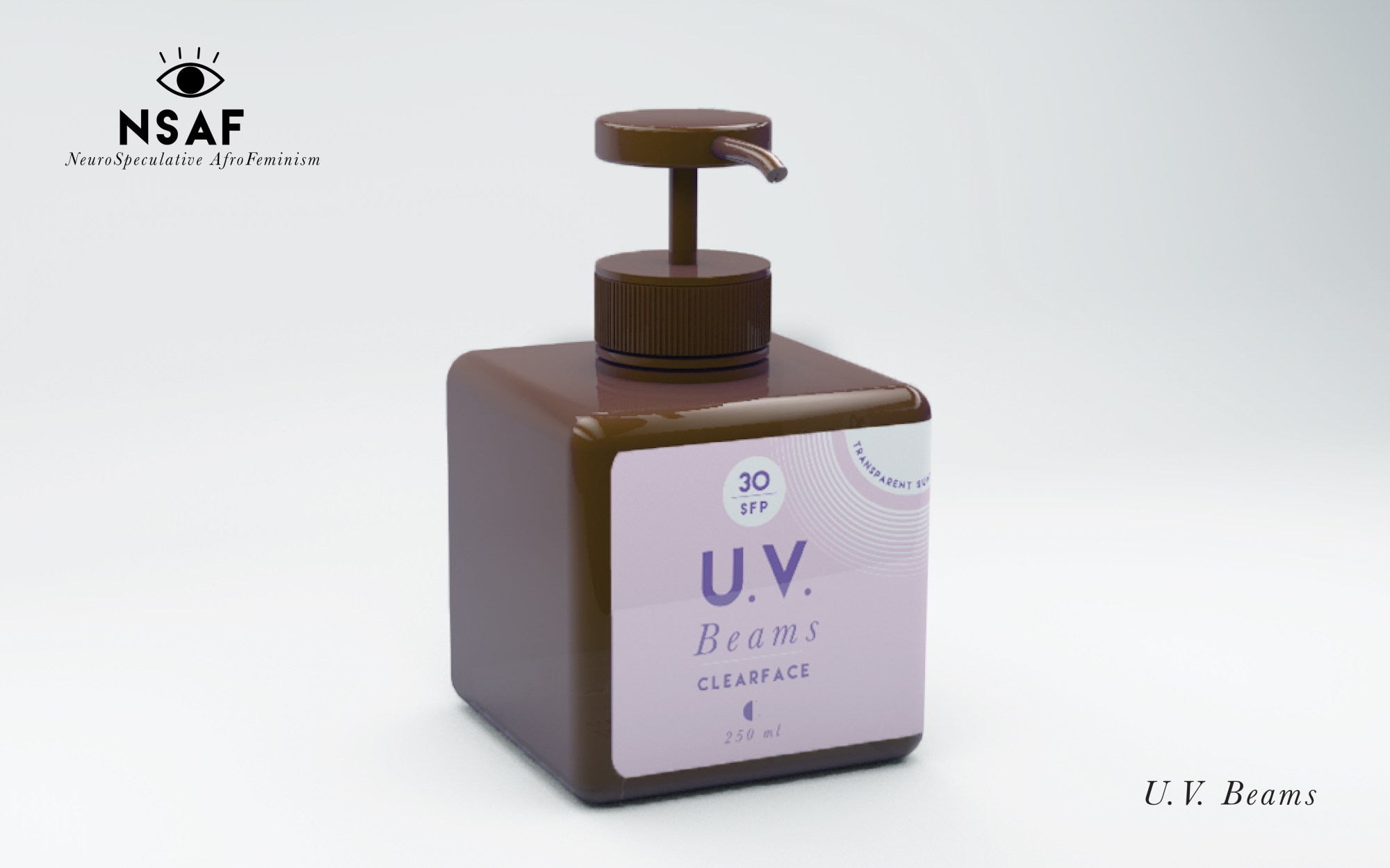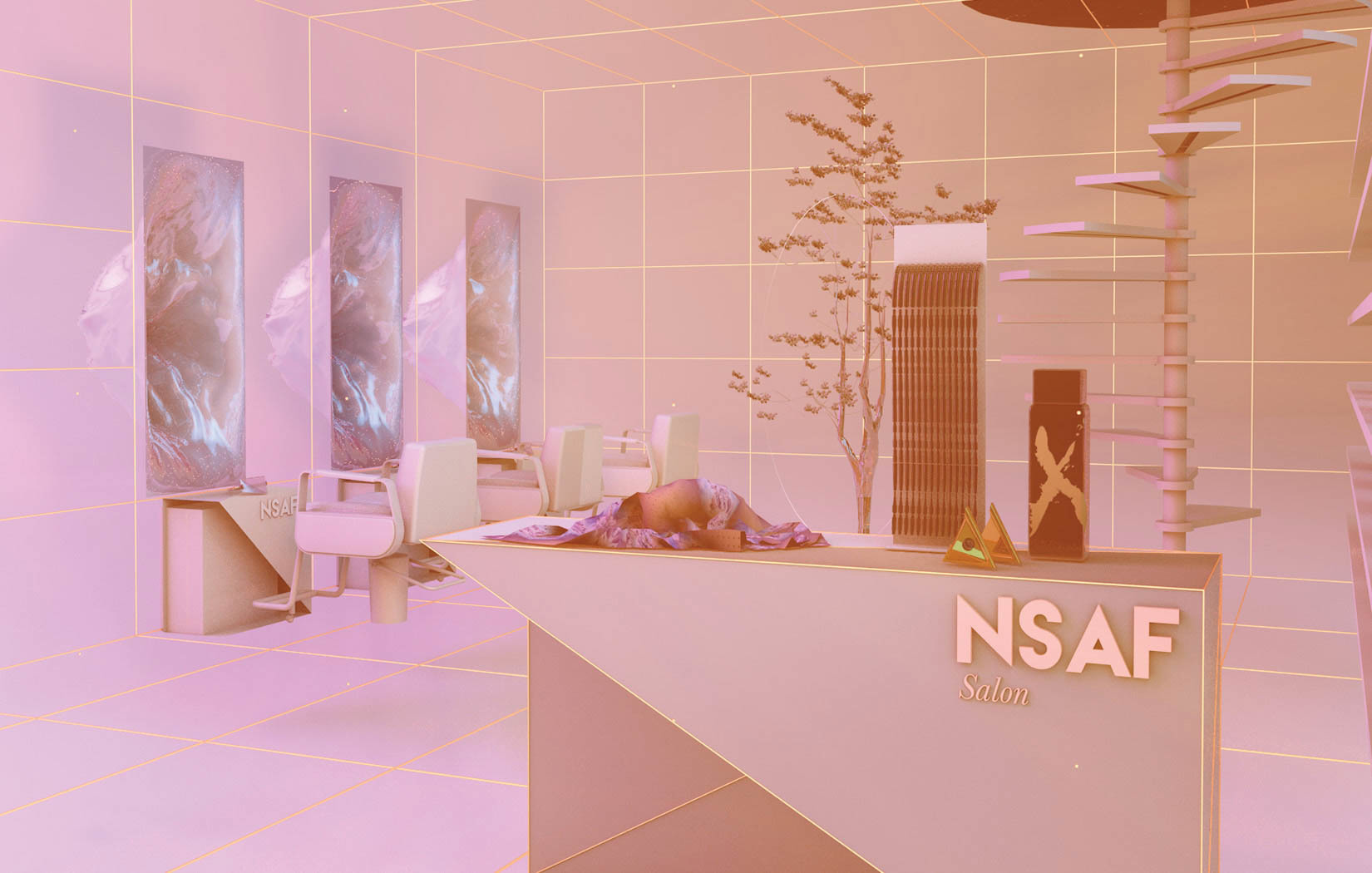First, the NeuroSpeculative AfroFeminism project tackled standard issue sunscreen. Last summer, Ashley Baccus-Clark and Carmen Aguilar y Wedge were living together in New York. On a trip to Storm King Art Center upstate, Ashley brought sunscreen. “It immediately discolored my skin,” she says. Carmen, standing next to her at an installation of their work at the Tribeca Film Festival this week, echoes her former roommate’s frustration. “There are transparent sunscreen solutions, but they’re really expensive,” Ashley continues, “Why is it the case that we have to modify products to fit us or we can’t use them?”
At the time, Ashley was working in a corporate office and Carmen was studying poetic computation, a discipline that fuses tech, coding, and art. “When we were living together last summer two unarmed black men were killed within a few days of each other. That’s how this project started,” says Ashley, who is a molecular biologist and artist. “We didn’t feel like we had the space to talk about that in what we were doing. We wanted to implement these self-care rituals in our routine.”
So they invented their own modes for self-care. As Hyphen-Labs, a design collective composed of women of color that Carmen co-founded in 2014, they created transparent sunscreen, a headscarf that scrambles facial recognition software, and a reflective visor that aims to deter microaggressions. The idea: the ScatterViz accessory would not only shield the wearer from the everyday degradations experienced by marginalized groups, it would also serve as a signal that the exchange wasn’t acceptable.
To demonstrate their products, they arranged the salon-inspired exhibit NeuroSpeculative AfroFeminism. It’s all sleek reflective surfaces and sly subversion. The team applied to Sundance with their project and the festival suggested they add a VR component. The powerful short film that resulted imagines the collective’s products in an elegant sci-fi story called “Neuro Cosmetology Lab.” It shows a world in which black women implement brain modulation through braiding techniques.
“It’s very heavily influenced by black women’s literature first and foremost,” says Ashley. Characters are named for Octavia Butler and Gwendolyn Brooks. And the salon’s color scheme — violet, pink, and ebony — borrows from Sampha’s taste for hazy brights and the distinctive palette in Barry Jenkins’s Moonlight, says Carmen.
Before you enter the VR experience, you sit in a swivel chair in front of a wavy mirror. It’s a true simulation of a salon experience, through the weird filter of the future. The stylist explains that you’re about to be free from all the constraints of reality. It feels excellent.
The slinky stylish spacey future was cast with animated goddesses, but it reminded me of an observation proposed by real bona fide goddess Zoe Saldana: the most powerful roles for women in movies today are usually in the future. If they’re writing in space, the writers and directors “give themselves the right to imagine the unimaginable.” In the future, according to Saldana and women of the “Neuro Cosmetology Lab,” there is liberation.
Standing between their inventions, their VR salon, and an intriguing canister of brain-shaped gummy candies at the Tribeca showcase, Ashley and Carmen talked about brain-hacking and new mythology.
Can you tell me more about what self-care means to you?
Ashley: Self-care as it relates to what’s going on in the world right now, is almost a preventative measure. It’s not: I’m going to make myself feel good because I’m worth it.
Carmen: It’s not necessarily manicures and massages. It’s more creating spaces to talk about what we’re feeling and how we can activate and work together to heal ourselves. We decided to come up with a speculative product line that addresses human-centered design and the needs and experience of women of color.
Ashley: The products have themes of security, protection, and visibility. One of the questions we want to ask is: Who are the designers creating products? Why aren’t designers considering the entire demographic when they create things? This is a call to action for designers. Because it seems like we keep having these conversations about diversity and inclusion and they’re not working. So if we create something physical, so that you can see that this is a tangible problem, maybe that will have more of an impact than talking about it or showing PDFs.

Tell me about how you incorporate these ideas into a VR film narrative.
Ashley: It’s not a narrative of blame, we’re not trying to isolate or ostracize anyone. Have you seen Hidden Figures? It’s an empowering story that needed to be told a really long time ago. We want to start that now, while virtual reality is at its inception. We want to highlight people who exist in this world, so they can see themselves in this technology. In film, it was 80 years before they saw themselves.
Carmen: Our stories can be highlighted through emerging technologies because they’re still being developed. We want to make sure our stories are being told now, so that these spaces don’t exclude us in the future.
The salon setting was always integral to your VR story. Why was that the choice?
Ashley: It’s a safe place in a lot of ways. It’s familiar. It’s across all nationalities. It’s intimate.
Carmen: There’s a negotiation, a modification. And historically it’s a place of political and social activation.
Ashley: Especially in the black community. And hair-braiding techniques have always been a ritualistic part of African culture. In Nigerian culture, hair-braiding techniques placed them in a realm that allowed them to communicate with the gods. We wanted to re-imagine that with transcranial stimulation.
Carmen: Transcranial stimulation only allows a certain number of people to use it, because it looks like a cap. This is a really crazy technology. If you have low levels of stimulation you can get into hyper-flow and focus states. But then, it stops because you can’t have access to it. What if you can have something that can put you into flow states in hair extensions?
Ashley: This is fringe. Neuroscientists, brain scientists, bio-hacking and quantified-self communities are using this. There are not a lot people of color in these communities. I would never be able to put cap on — I would have to cut my hair or modify myself to be a part of this. If there is a certain segment of people who are optimizing their brains, I want to know about it and I want to be part of it. This is something I probably could have learned about in a beauty salon or hair salon.
Carmen: And we are always trying to see if VR can be a simulation of this technique. Do we have to be sending our brains impulses to activate hyper-flow and focus states? We are trying to simulate that in the VR experience, because you have someone’s undiluted attention for a certain period of time. A lot of people say it can be an empathy machine. Maybe it can be an optimizing machine. It can get you through creative road blocks. It can inspire you and empower you.

I was really into the role of the body in your VR experience. You saw yourself in the mirror and you could look down and see your character’s legs and arms.
Carmen: With VR, people can turn and see themselves. This is me. We are looking at the idea of embodying a new character. Often in VR we are body-less. We are floating through spaces and exploring these new places, and but we don’t know who we are. You can see from the light leak that you’re still there, but your brain is so disconnected from your body.
What’s the most important component of this exhibit to you?
Ashley: We are trying to build a world that highlights and uplifts our stories of who we are. We are trying to create a new mythology of this space. Old civilization has fallen, and by old civilization, we mean how black women are portrayed in media. Most people, their information about other cultures is what they see on television or news or in movies. A lot of time it’s very one-dimensional.
Carmen: We are also saying something to our younger selves. To young girls who want to see themselves portrayed as women in technology, in research and in science. That’s where we were when we were working right after college and we didn’t see any stories that were around black and brown women in technology. This is speaking to that as well. There is a place for this.
This interview has been edited and condensed.
Credits
Text Maggie Lange
Images courtesy of Hyphen-Labs
